33 results
Congo Atrocity Lantern Lecture
Background
About the Collection
The ‘Congo Atrocity Lantern Lecture’ was a campaigning devise used by the Congo Reform Association to raise awareness in Britain of the brutal labour regime which took place when the Congo Free State was the personal possession of King Leopold II during the period 1884-1908. The lantern slides included a range of images which represented different experiences of enslavement from transatlantic slavery through to conditions in the Congo Free State. Some of the lantern slides reproduced photographs taken by the British missionary Alice Seeley Harris which depicted the violence and mutilation inflicted on the local population in pursuit of rubber.
The Congo Reform Association was founded in 1904 by Edmund Dene Morel and Roger Casement to highlight the issue of exploitation in the Congo Free State. Despite their efforts the initial public success of the campaign had started to wane. In 1905 Alice Seeley Harris and her husband John returned from the Congo Balolo Mission where they had been posted and began to take an active role in the Congo Reform Association. The Harrises offered a solution for reanimating the campaign – a lantern lecture tour that would showcase Alice’s photography and incorporate elements of the popular missionary speaking tours that had been used to evangelise across Britain and the United States.
The lantern lecture shows utilized the popularity of the genre as a form of mass entertainment. Using missionary networks it was shown in chapels and meeting houses across Britain. The lantern slides were accompanied by a lecture which was delivered by the Congo missionaries. As the shows grew in popularity it became necessary to develop a standard narration that could be delivered by any speaker. The standard lecture focused on the idea that the Congo Free State represented a corruption of the spirit of empire rather than an acute symptom of a structure that was inherently unjust. The accompanying lecture notes made it clear that African people and their culture should not to be regarded as equal to that of the Europeans. The lecture expressed sentiments framed by a belief in Britain’s empire as part of the ‘civilising mission’ – this was an attempt to remake colonised people in the image of the coloniser. Far from anti-colonial the lecture reinforced the need to participate in the imperial project, particularly in relation to spreading Christianity through the establishment of more mission outposts.
Guide for users
You can search the images using geographic location. The original spelling of the place names contained within the caption have been used for the title of the image, however, some place names have changed their spelling over time e.g. ‘Loanda’ and ‘Luanda’. ‘Tags’ have used the modern spelling of the place name. Items are tagged with place names from the period as well as the modern place name e.g. ‘Leopoldville’ and ‘Kinshasa’. You can search via ‘Country’ - the place where the image was produced e.g. ‘Angola’. You can search the ‘Tags’ for a particular region, city, or village e.g. ‘Kasai’.
The images have been tagged using generalised description of the individuals who feature in them e.g. ‘African child’ or ‘European man’. These terms are inadequate as they do not allow for the specificity that should be attributed to individual subjectivity, they also remove peoples’ right to self-definition. The captions for the images do not contain the detailed information about the sitters which would allow for a greater degree of clarity. Judging a person’s race or ethnicity based on a photograph risks wrongly attributing or imposing meaning, however, in order to make the archive searchable these terms have been used.
Each image has a zoom function will allows the viewer to examine the photograph in detail. If you click on the image you can navigate with the zoom to look at an individual’s stance, expression, and other details. Humanitarian photography has employed techniques which have tended to erase the individual and present a suffering mass. The zoom function has been included so that viewers can engage with the people represented as individuals.
The ‘Congo Atrocity Lantern Lecture’ used a selection of photographs from a wider collection of 509 images created by Alice Seeley Harris. To view the full collection you can search ‘Related Items’ or you can click through to the ‘Alice Seeley Harris Archive’.
Both the original ‘Alice Seeley Harris Archive’ and the ‘Congo Atrocity Lantern Lecture’ represented African people through the colonial gaze. In replicating these archives we are very aware of the potential to reinstate that particular way of seeing difference. In order to make sure that this mode of representation is balanced by material which is self-representative we have commissioned two projects ‘Decomposing the Colonial Gaze: Yole!Africa’ and ‘You Should Know Me: Photography and the Congolese Diaspora’. You can search ‘Alternative Tags’, or you can click through to these collections to find new material which has been inspired by and critically engages with the historic archive.
The project has also collaborated closely with the Antislavery Knowledge Network, which is based at the University of Liverpool, and seeks community-led strategies for creative and heritage-based interventions in sub-Saharan Africa.
Copyright and takedown policy
Copyrights to all resources are retained by Antislavery International, who have kindly made their collections available for educational and non-commercial use only. All efforts have been made to obtain copyright permission for materials featured on this site. If you are aware of instances where the rights holder(s) has not been given an appropriate credit, please let us know. If you hold the rights to any item(s) included in this resource and oppose to its use, please contact us to request its removal from the website.
Contact
Email: [email protected]
Acknowledgements
This archive would not have been possible without the generous access given to the project by Antislavery International. In particular we would like to thank Dr Aidan McQuade and Dr Anna Shepherd. The digitisation was completed by Autograph ABP. Thanks to the London School of Economics for their kind permission to reproduce the lantern lecture notes. Discussions about this project were greatly enhanced by conversations with Dr Mark Sealy (Director, Autograph ABP) and Dr Richard Benjamin (International Slavery Museum). Congolese artist Sammy Baloji offered unique insights into the relationship between past and present forms of representation. This project was supported by the Arts and Humanities Research Council. Further thanks go to the Antislavery Knowledge Network, based at the University of Liverpool.
Further reading
Kevin Grant, ‘Christian critics of empire: Missionaries, lantern lectures, and the Congo reform campaign in Britain’, Journal of Imperial and Commonwealth History, 29:2, (2001), pp. 27-58
Dean Pavlakis, British humanitarianism and the Congo reform movement, 1896-1913 (Surrey: Ashgate, 2015)
Andrew Porter, ‘Sir Roger Casement and the international humanitarian movement’, Journal of Imperial and Commonwealth History, 29:2 (2001), pp. 59-74
Links
Archive of Edmund Dene Morel held at the London School of Economics
Antislavery Knowledge Network, University of Liverpool
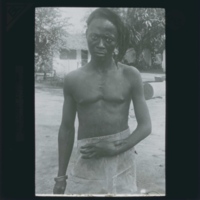
Lomboto of Bolumboloko
Lomboto of Bolumboloko shot in the wrist and hand by ABIR Anglo-Belgian India Rubber Company sentries. Information taken from the Special Congo supplement to the West African Mail Sept 1905. This image formed part of the Harris Lantern Slide Collection. Under King Leopold II the Congo Free State…

Chapel Built by British Missionaries
The chapel being built used free labour. British missionaries in Belgian Congo. This image formed part of the Harris Lantern Slide Collection. Under King Leopold II the Congo Free State used mass forced labour to extract rubber from the jungle for the European market. As consumer demand grew King…
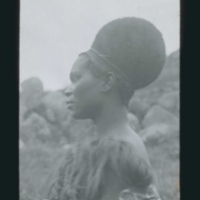
African Woman in Profile
African woman in profile. This image formed part of the Harris Lantern Slide Collection. Under King Leopold II the Congo Free State used mass forced labour to extract rubber from the jungle for the European market. As consumer demand grew King Leopold II's private army - the Force Publique - used…
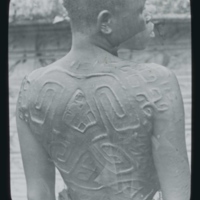
African Woman with Traditional Scarification
African woman with traditional scarification on her back. This image formed part of the Harris Lantern Slide Collection. Under King Leopold II the Congo Free State used mass forced labour to extract rubber from the jungle for the European market. As consumer demand grew King Leopold II's private…
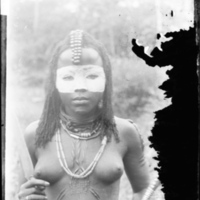
African Woman Described as a Witch
African woman described as a 'Witch at Euli, Ikelemba'. This image formed part of the Harris Lantern Slide Collection. Under King Leopold II the Congo Free State used mass forced labour to extract rubber from the jungle for the European market. As consumer demand grew King Leopold II's private army…
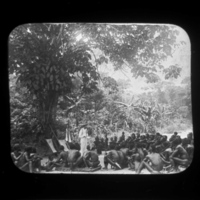
British Missionaries Preaching in the Congo
British missionaries preaching in Belgian Congo. This image formed part of the Harris Lantern Slide Collection. Under King Leopold II the Congo Free State used mass forced labour to extract rubber from the jungle for the European market. As consumer demand grew King Leopold II's private army - the…

British Missionaries Preaching in the Congo (2)
British missionaries preaching in Belgian Congo. This image formed part of the Harris Lantern Slide Collection. Under King Leopold II the Congo Free State used mass forced labour to extract rubber from the jungle for the European market. As consumer demand grew King Leopold II's private army - the…
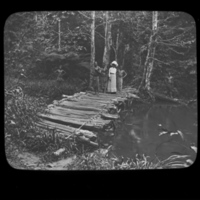
Alice Seeley Harris Crossing the Bridge
Alice Seeley Harris crossing a bridge with a group of Africans. This image formed part of the Harris Lantern Slide Collection. Under King Leopold II the Congo Free State used mass forced labour to extract rubber from the jungle for the European market. As consumer demand grew King Leopold II's…
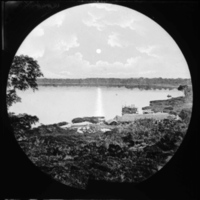
Steamboat
Unknown. This image formed part of the Harris Lantern Slide Collection. Under King Leopold II the Congo Free State used mass forced labour to extract rubber from the jungle for the European market. As consumer demand grew King Leopold II's private army - the Force Publique - used violent means to…
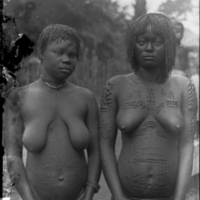
Two African Women with Traditional Scarification
Two African women with visible traditional scarification. This image formed part of the Harris Lantern Slide Collection. Under King Leopold II the Congo Free State used mass forced labour to extract rubber from the jungle for the European market. As consumer demand grew King Leopold II's private…
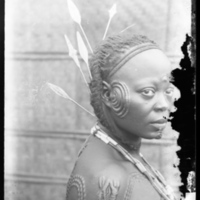
Young African Woman
Two descriptions exist for this image. The first is taken from the original photograph held at the Bodleian Library in Oxford. It reads 'An Ikelemba woman with tribal mark.' The second is taken from Antislavery International website's and reads 'Ngombe woman from the Bangalla region of the Upper …
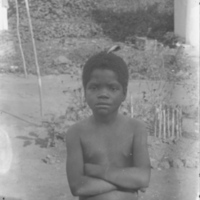
African Child
African child. This image formed part of the Harris Lantern Slide Collection. Under King Leopold II the Congo Free State used mass forced labour to extract rubber from the jungle for the European market. As consumer demand grew King Leopold II's private army - the Force Publique - used violent means…
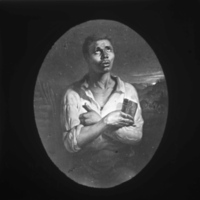
Praying Man
Unknown. This photograph formed part of the Harris Lantern Slide Collection. Under King Leopold II the Congo Free State used mass forced labour to extract rubber from the jungle for the European market. As consumer demand grew King Leopold II's private army - the Force Publique - used violent means…